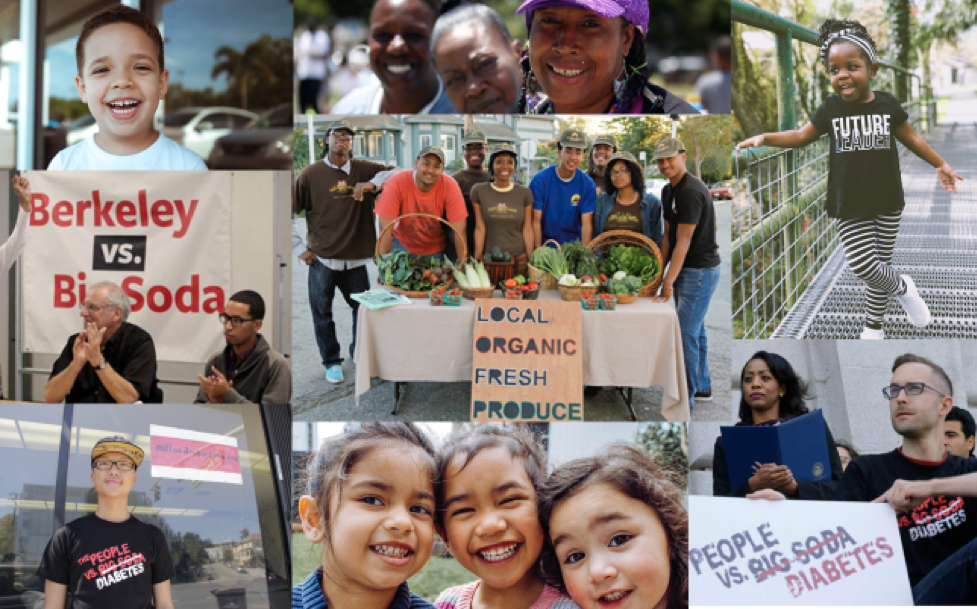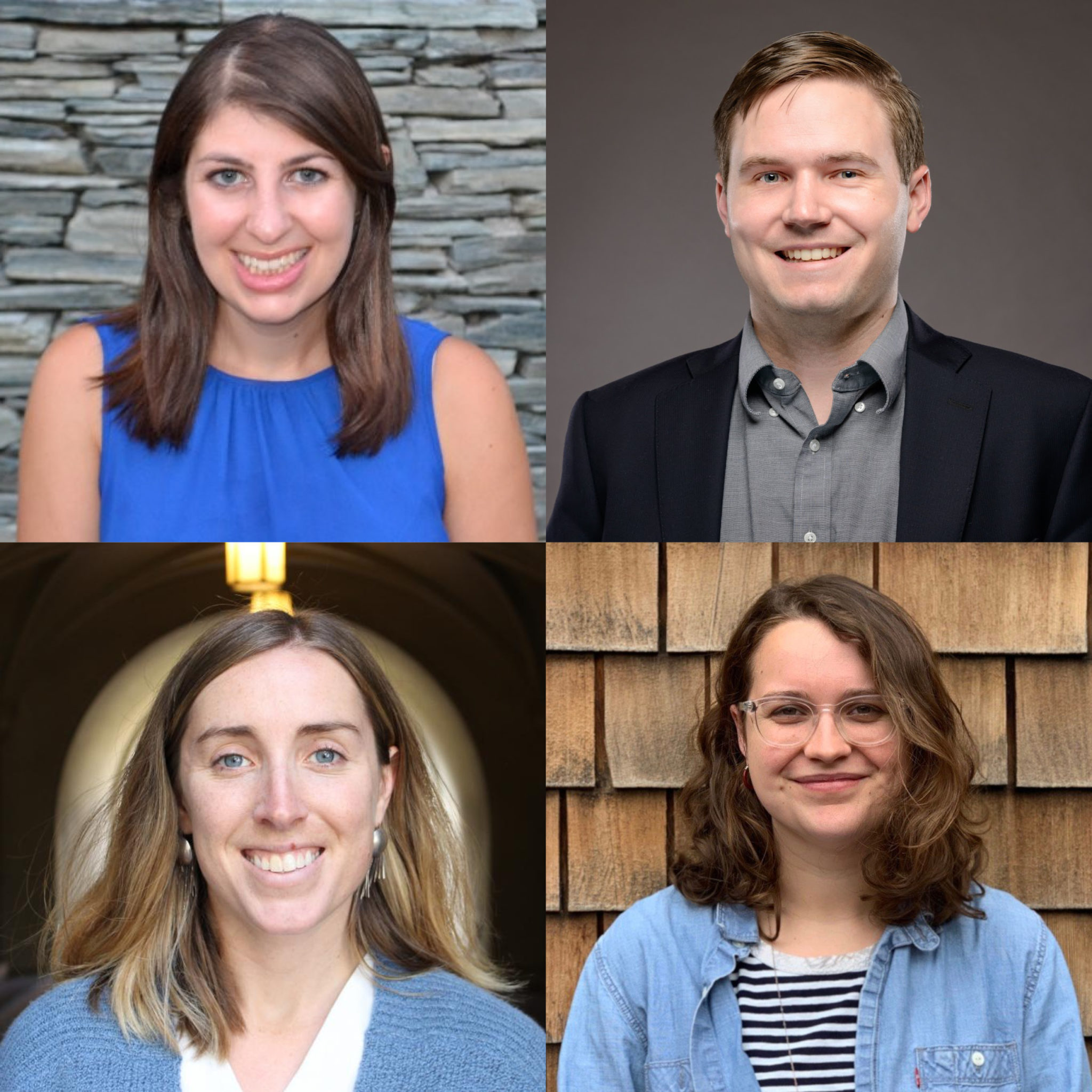By Sydney Bennet, Nick Draper, Irene Farnsworth, and Fiona McBride
All authors are Master’s of Public Policy students at the Goldman School of Public Policy at UC Berkeley. (From top left clockwise: Bennet, Draper, McBride, Farnsworth)
In 2014, with the passage of Measure D, the city of Berkeley, California became the first municipality in the United States to pass a tax on sugary drinks, with the intent of improving public health and reducing the prevalence of diet-related illness. In 2016, the Bay Area cities of Albany, Oakland, and San Francisco followed suit by passing citizen-led initiatives creating sugary drink taxes of their own. The beverage industry spent heavily attempting to defeat these initiatives and has invested in continuing to sow doubt about how cities would spend sugary drink tax revenue to dissuade voters and elected officials in other cities and states from passing sugary drink taxes. While voters in each of these cities supported sugary drink taxes by fairly strong margins—with each initiative receiving at least 60 percent of the vote—residents are still largely unaware of how the tax dollars are being allocated. In January, our Goldman School of Public Poilcy Introduction to Policy Analysis team set out to investigate the actual implementation of sugary drink tax revenues in those four Bay Area cities, in partnership with the Praxis Project and the Berkeley Food Institute. In a new report, we looked at these aspects of the tax allocations: 1) administrative structure; 2) grantmaking; 3) evaluation; and 4) political and policy considerations for future soda tax initiatives.
Background
Americans face a national diet-related disease epidemic; 70 percent are overweight or obese, and in California alone, more than half of residents are diabetic or on track to being so.[1] This crisis has disproportionately negative impacts on low-income communities of color. Black residents in Berkeley are four times as likely to have diabetes as white residents, and are hospitalized for the disease at 14 times the rate of white residents.[2] Social determinants of health contribute to these inequities and a complicated web of structural and institutional racism, ranging from inequitable food access to targeted marketing to people of color by soda companies, perpetuate the problem. If there were true health equity, these disparities could be alleviated. Advocates believe that a sugary drink tax is one intervention which, alongside other public health measures, can challenge health inequities and disparities. They see SSB taxes as a tool not only to curb soda consumption, but have the potential to decrease the impacts of soda consumption for communities hit hardest by diet-related illness, while reinvesting financial and material resources in those communities.
The four Bay Area sugary drink taxes passed as general taxes, rather than specific taxes, meaning that any money raised is deposited in the respective city’s general fund, rather than being earmarked for spending on health-related initiatives. That being said, thanks to political momentum and commission models in the three of the four cities[3], the funds have largely been spent on health-related programs to date, such as school water infrastructure, gardens, and health education; parks; and physical activity promotion. Our report outlines where the revenues from Bay Area sugary drink taxes have been spent, and proposes guidelines for municipalities on how to best design a sugary drink tax. We looked at the following areas:
Administrative Structure
Berkeley, Oakland, and San Francisco created new committees to make recommendations on how to disperse the new soda revenues, while in Albany revenue is allocated directly by the City Council. We found that effectively designing the administrative structure is a critical part of implementation because these bodies dictate how funding priorities are set and play a key role in ensuring funding allocations mirror the legislative intent of the initiatives. Allowing for flexibility in commission membership ensures that the commission will be most effective in providing a robust community voice and oversight of the revenue distribution process. Oversight commissions are useful tools for incorporating community voices into decision-making and allow for flexibility in funding programs that represent the most pressing priorities for communities impacted by sugary drink consumption.

The authors’ new report: Bay Area Sugar-Sweetened Beverage Taxes: An Evaluation of Community Investments
Grantmaking
To varying degrees, the Bay Area cities provide funds for city and school district programs and make grants to community based organizations (CBOs) through a request for proposal process. Cities are currently considering how their grant processes reach communities most in need. To do this, they may need to adjust their processes for smaller, nontraditional grants to grassroots CBOs and offer two year grants. For example, San Francisco hopes to use the funds to support smaller, grassroots organizations, which requires building additional infrastructure and reporting capacity, and Berkeley has begun making grants on a two-year cycle to provide more stability to CBOs.
Evaluation
Each of the four municipalities specified structures for tracking tax collection, and all but Albany also stipulated grant and impact evaluation requirements. Berkeley’s sugary drink tax offers a good blueprint for robust evaluation efforts, but has faced challenges around financial transparency between the city and commission. Cities should have a dedicated portion of sugary drink tax revenue set aside for evaluation and have appropriate requirements for evaluation that do not burden smaller CBOs.
Political and Policy Considerations for Future Soda Tax Initiatives
Sugary drink taxes remain contentious in many communities around the U.S. and thus far only a handful of cities have implemented them. This controversy stems in large part from the beverage industry’s relentless marketing and lobbying campaign against them. However, aside from this campaign, there is a danger for sugary drink taxes to be regressive (unfairly borne by low-income communities). Another danger is the sometimes-paternalistic approach of public health advocates who may devalue equity when designing policy interventions.
While it is too early to assess the long term health impacts of sugary drink taxes in the cities we looked at, we find that Albany, Berkeley, Oakland, and San Francisco have, to varying degrees, made equity a focus as well as taking steps to ensure robust and sustainable political support for sugary drink taxes. All four cities enacted their taxes via ballot initiative and three of them[4] created citizen commissions to guide city leadership on spending of funds raised from sugary drink taxes, giving the community consistent opportunity to be involved in the policy enactment and implementation process. The Bay Area cities have also been able to show a direct link between their sugary drink taxes and valuable community programs. The more that cities can do to accelerate this process and show clear benefits of sugary drink taxes, the more durable and politically sustainable they will be.
[1] Prediabetes in California: Nearly Half of California Adults on Path to Diabetes.” UCLA Center for Health Policy Research. http://healthpolicy.ucla.edu/publications/search/pages/detail.aspx?PubID=1472. Retrieved April 2019.
[2] City of Berkeley Public Health Department. City of Berkeley Health Status Report 2013. https://www.cityofberkeley.info/uploadedFiles/Health_Human_Services/Level_3_-_Public_Health/BerkeleyHealthReport_online_FINALv2.pdf.
[3] Berkeley, Oakland, and San Francisco
[4] Berkeley, Oakland, and San Francisco
